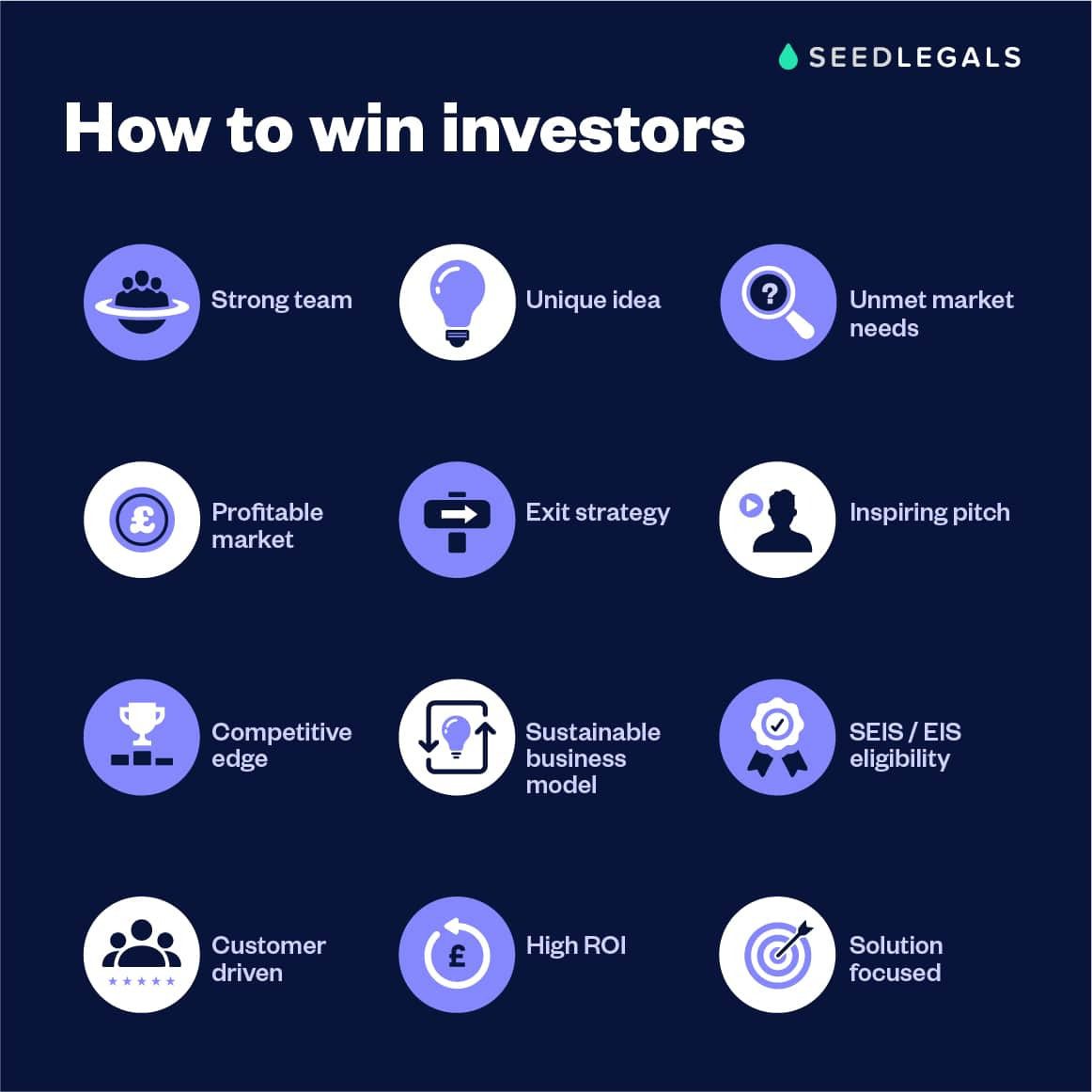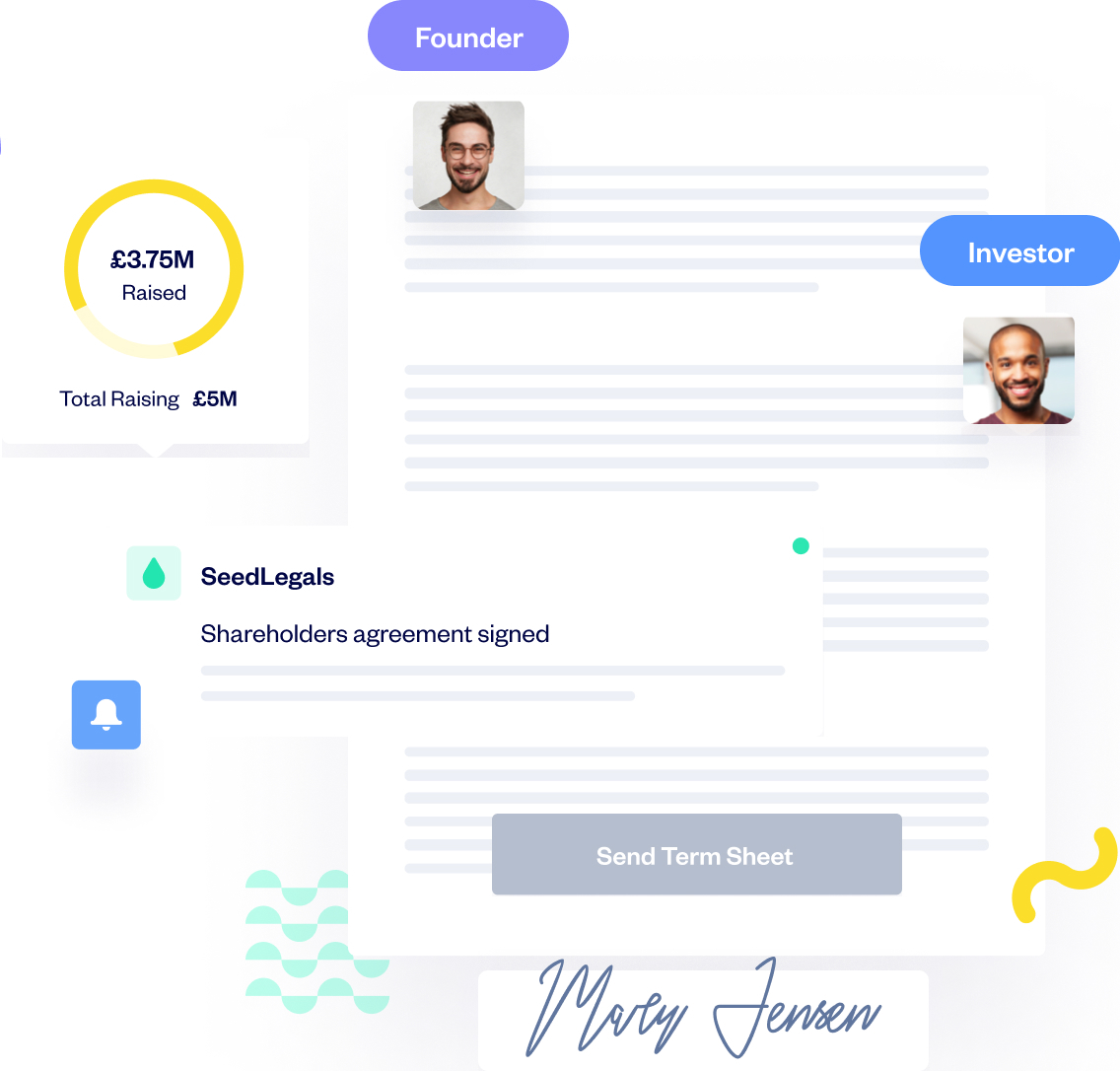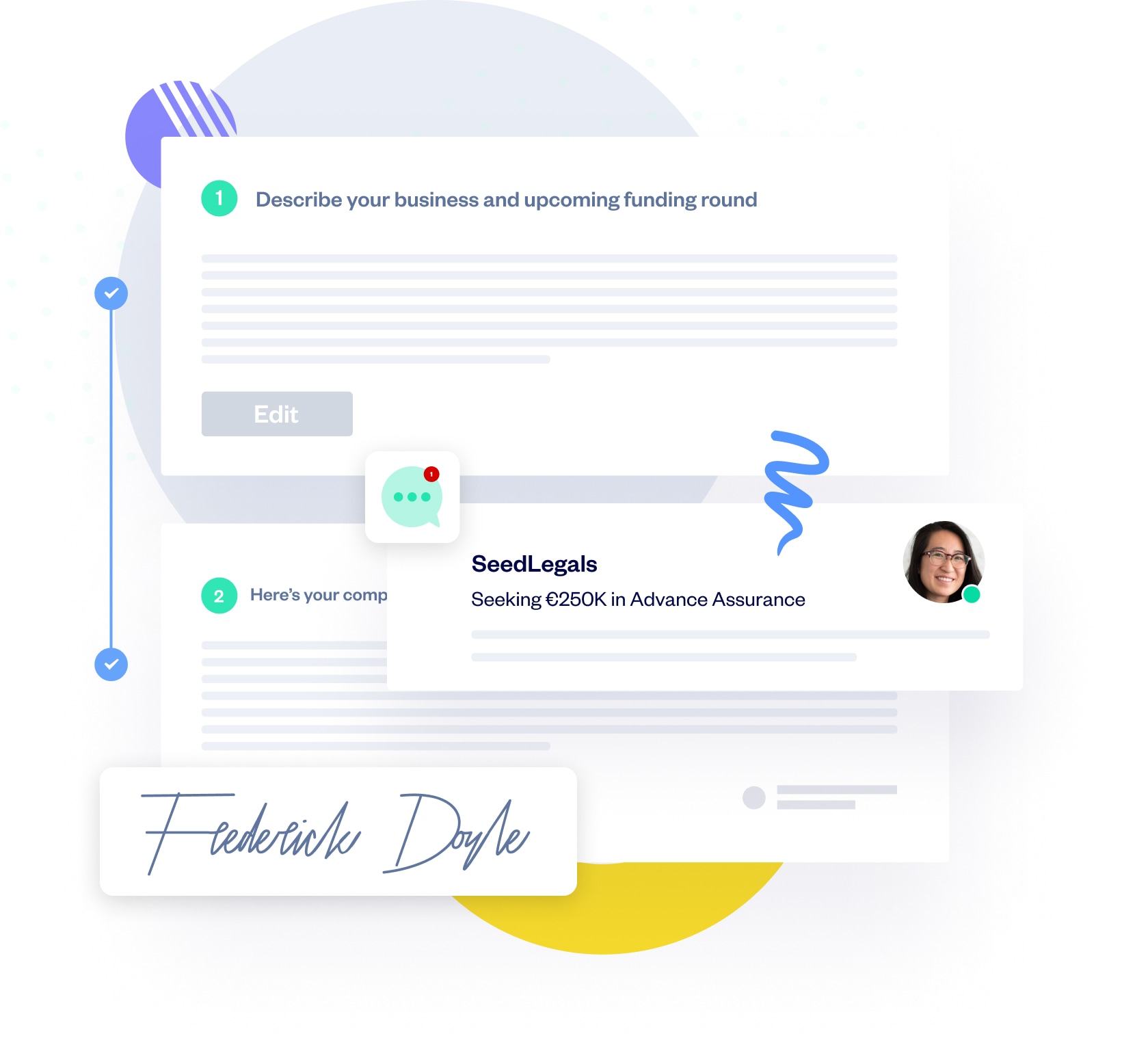Startup funding strategies for 2025
With data, experience and insights gained from £2B+ raised on SeedLegals, we’ve curated these top three funding strategi...
You’re itching to pitch. You’re ready to raise. You believe wholeheartedly in your company’s potential to achieve success… but how do you actually get investors to believe in you and become seriously interested in investing in your company?
Raising startup funding is a cut-throat endeavour. At SeedLegals, we’re dedicated to simplifying the startup funding journey so we’ve created this article to help you perfect your pitch.
Below, we’ll share insights on what investors look for and our top tips on how to pitch to them based on research gathered from venture capitalists and angel investors. And don’t miss the video interview with investment expert, Phil McSweeney of AngelThink.
What a lot of investors look for comes down to a global, sustainable, under-served (or unmet) market need:
Global – ambitions to expand outside the startup’s country
Sustainable – business model that will last, in principle, forever
Under-served – there could be competitors, but the market is large enough for multiple suppliers
Unmet – if the need is unmet, then the startup may have to educate the market (a frighteningly expensive prospect) or the market may not be ready – compare the Apple Newton with the iPad – similar products but introduced 17 years apart, and the iPad has been 10,000 times more successful
Market – the product/service is capable of being profitably monetised
Need – the market has a need, not a wish or desire
But what each investor looks for specifically (both angels and VCs) is unique to their personal goals and interests. Ultimately, they’re all looking for a return on their investment and a capable team to invest in. We’ve asked some investors what they look for in a pitch.
Yana AbramovaSpeak less, but in-depth: I like when pitches are concise and straight to the point. Give an overview of the market and define the problem you solve (supported by numbers). Be clear about the solution your company offers. Why now and why this team is what you should focus on communicating.
Be natural, be yourself: People can easily tell if you pretend to be someone you are not. At pre-seed/seed stage the first and foremost thing is the team and founders, so show who you are authentically.
Don’t bluff: Be honest and authentic. Don’t be arrogant and claim to have a lot of interest from other investors. Even if it’s true, this doesn’t make the investors you’re pitching to more interested.
Know your numbers and be ready to make a deal: Investors speak about numbers, so you should know your business plan inside out. You must be ready to tell us how much money you’re raising in your funding round and what you want from the deal. Investors are not shy to speak about money – it’s their business.
Founder & managing partner,
Oliver KicksI look for a strong team who comes across as competent and insightful. I want them to teach me something about their market and walk away feeling excited about this new insight or data point.
Principal,
Jonny SeamanAs an angel investor focused on pre-seed stage, I look for founders who’ve been involved in their industry before because they know the ins and outs of the industry and they have contacts that they can use to make it work. The personality and experience of the founders mean a lot at this stage. I also look for companies that can prove they’re growing and have potential to get big.
Investor partnerships manager,
Early stage pitches will look different to growth stage pitches. While the same tactics apply to both, there will be some key differences in your pitch content. Early stage pitching is more focused on proving that you’re investable people, while growth stage pitching is about proving that you’re an investable business based on what you’ve already achieved.
Early stage
Focus on the team and the people behind your company. You have fewer successes behind you because you’re very new, so you’ll need to show that the people on your team are capable of creating your future success. Key points in an early stage pitch include:
Growth stage
When you raise at Series A (and B, C and beyond) you’ll need to focus more on what you’ve already achieved and how you plan to double, triple or 10x this. Growth stage pitches are more reliant on metrics. Key points in a growth stage pitch include:
Another key difference between early and growth stage pitching is who you pitch to; at early stage, it’s more likely to be angel investors, and at growth stage, VC funds. More on that in the section below – keep reading.
SeedLegals Advisory gives you access to legal advice from experienced venture capital lawyers while keeping your legal costs low.
We’ve gathered insights from multiple investors and thousands of founders who’ve successfully raised funding to compile our top tips on how to pitch. These tips apply to both early stage and growth stage companies.
Sure, you believe in your company, and you think it’s a great idea – but investors are used to seeing a lot of ideas. So before you contact an investor or pitch to them, here are some points to consider.
Angel vs VC
The first thing to do is figure out whether you’re looking for angel investment or venture capital funding. If you’re in the very early stages and looking for pre-seed or seed funding, you’ll probably be more successful if you seek angel investment. One of the most common problems we see at SeedLegals is founders pitching to VC funds too early and being told by investors, ‘Love what you’re doing – but come back later.’
Do your research to understand which type of investor you need to pitch to. There are some VC funds in the UK that invest at early stages, though, so find out if there are VC funds that align with your company at this stage.
Consider the investor’s goals
If you were the investor, what goals would you be aiming to achieve by investing in a company? It’s important to do your research on each investor to understand more about their goals and interests.
💻Do they invest in your particular industry?
✊Do they want to invest in a good cause?
🌿Are they interested in ESG issues that your company helps solve?
💸How is your company going to give them a return on their investment?
Don’t waste time
Investors and founders are busy people. Neither of you has time to waste. Before making contact with an investor, make sure:
✅They haven’t invested in direct competitors
✅They can invest the amount you’re looking for
✅They invest in the stage of growth your company is in (ie early stage or growth stage)
If an investor shows interest in your company, make sure that they’re seriously considering investing in you before moving forward, and remember to keep things as brief and to the point as possible in your communication.
Always think from the perspective of what’s in it for them
Remember throughout your pitch and in any communication with potential investors, bring every point back to what they can gain from investing in your company. When you pitch, what’s in it for you is always secondary.
Show your route to ROI
Investors need to know they’ll get a return on their investment. Make sure that your pitch is clear about how investors will see that return. Focus on:
Jonny SeamanIt’s essential to pitch from the angle of what’s in it for the investor rather than what’s in it for you. Do your research and understand what each investor wants. Then tailor your pitch as much as possible to show why you’re a good fit for them.
Investor partnerships manager,
Your pitch deck is your opportunity to tell an engaging story and sell your idea. Investors either lose or gain interest within the first few slides of your pitch deck, so it’s essential to get it right:
To read more about what to include in your pitch deck and download our free pitch deck template (which includes step-by-step guidance and expert tips) check out Startup pitch deck: free template with investor tips.
Build and share your pitch deck in minutes and monitor investor interest.
Oliver KicksFocus on what your edge is as a team, and why you’re uniquely placed to build this company and solve the problem for your target customers/users. Everything else should feed into this central narrative.
Principal,
Your team is one of the top priorities for investors when deciding whether or not to invest in a company. You need the right team to be able to execute your idea successfully. To gain the trust of investors, they need to see experience, expertise and industry knowledge in your team.
Make sure you show off your brilliant team in your pitch deck (closer to the front of the deck is better than leaving it until the end) and dedicate enough time to talk about their expertise and achievements. You can also mention advisors and mentors to emphasise how the company benefits from their ongoing expert support.
Investors want to feel excited about an opportunity during and after a pitch. Don’t just talk through your slides. Your pitch should tell a story about what your company is doing. Show your passion to leave them inspired and excited.
Anthony RoseMy take is that a great pitch tells a story like a Hollywood drama: It needs to establish the proposition and create desire, excitement and tension. And then it needs to end with investors wanting to come back for the sequel.
CEO and co-founder,
Think about how you can keep investors as engaged as an audience watching a trailer for a new movie blockbuster:
So how do you create an engaging story for your pitch? Every story needs drama. When you pitch, the ‘drama’ in your story is the problem you’re solving. This should be the driving force of your narrative.
Investors are interested in the problem you solve for your customer. They’ll lose interest quickly if you talk through complex details about what you do. Tell them why you exist, what problem you’re solving and why your solution to this problem is so exciting. Be clear about how you’re solving the problem and avoid abstract ideas.
Investors want to see that your product or service will fulfil a need in the market because that’s how you’ll generate revenue and give them their return on investment. When you pitch, make sure that you’re clear about:
You need to show that you understand your competition. Investors want to know what competition you’re facing in the market and they want to be confident that you’ve got an advantage over your competition. In your pitch, briefly cover who your competitors are and how your solution is more appealing than theirs (in terms of pricing, experience and quality).
What have you achieved so far? If your company has experienced some success already, you’ll want to share that in your pitch. This will help investors feel confident and excited about your company. Include successes such as:
Building a strong workforce is integral to success. If you can show investors that you’re committed to attracting and retaining top talent and getting your employees aligned with company goals, they’ll be more confident in your ability to achieve success.
In your pitch, it’s worth mentioning how you plan to attract, retain and motivate talent through benefits such as share option schemes.
If you have an exit strategy, you’ll want to talk through that at a high level. You’ll be at an advantage if investors can see a clear route to exit (in other words, when they get their ROI).
If you’re in the early stages, don’t worry if you don’t have an exit strategy. For growth stage companies though, it’s a good idea to cover your exit strategy in your pitch.
Do you plan to:
One of the most important parts of your pitch is ‘the ask.’ This is where you tell investors what you need from them. Include a deal summary slide in your pitch deck to cover:
Give investors what they want: proof that they’ll get SEIS/EIS tax relief
After you pitch to investors, if they liked what they heard, they’ll ask for follow-up information. Make sure you follow up as soon as possible.
Sometimes they’ll ask you to come back after you’ve hit a certain milestone (for example, made your first sale) so focus on what you need to achieve and follow up again as soon as you’re ready.
Oliver KicksIf you follow up with what was asked for, you will generally stand out above 90% of founders! I’d usually wait until that evening/the following day to keep the momentum going.
Principal,
In this video, watch the webinar recording of our CEO Anthony Rose talking to coach, mentor and founder of AngelThink, Phil McSweeney. Find out how to understand what investors are looking for, how to craft the perfect pitch to tap into their desires (of both the head and the heart) and how to secure their investment and ongoing support.
In this video, Anthony Rose from SeedLegals and prolific investor Marc Cohen from unbundled.vc help show how to do cold intros, find the right investors, tell a great story, and get investors on board. Marc is well known for providing honest and actionable investor feedback. He shares the lowdown on decoding investor feedback, and more.
Raising startup funding? Or thinking about it? We can help.
When you use SeedLegals to raise, you get unlimited support from our funding strategists, who can guide you through your raise.
With over £1.3 billion in deals closed on our platform, we have the experience and data to help you:
✅ Understand your funding options
✅ Make informed decisions about your investment deals
✅ Navigate your deal to achieve the best outcome for you and your company
✅ Save time and money on your funding admin and legals










